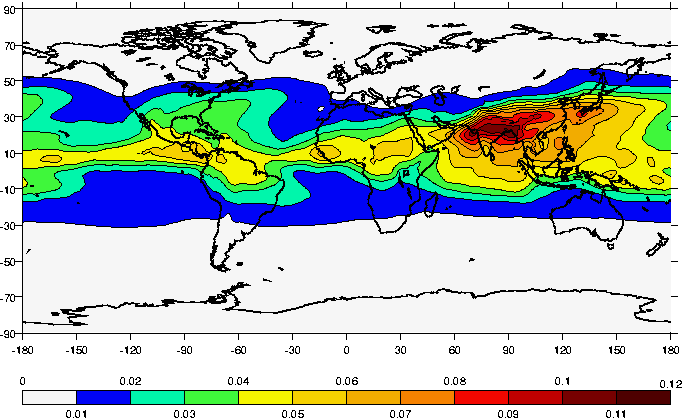
Water vapour in the upper troposphere and lower stratosphere has an important
influence on the climate system and plays a crucial role in stratospheric chemistry.
Therefore it is important to understand the processes which determine its transport
and distribution in these regions of the atmosphere, including the processes
by which moisture can be exchanged between the troposphere and the stratosphere.
The Asian summer monsoon is an important moisture source for the upper troposphere (Fig. 1). In this study meteorological and humidity data from the ECMWF Re-Analysis data set have been used, and a mechanism has been identified by which the Asian summer monsoon can moisten the northern extratropical lower stratosphere. A schematic of this mechanism is shown in Fig. 2.


The mechanism involves interactions between mid-latitude synoptic disturbances and the upper level monsoon anticyclone. During these interactions, moisture is transported irreversibly into the northern extratropical lower stratosphere. The mechanism operates in the following way:
(a) Undisturbed case: Gradients of potential vorticity north of the monsoon anticyclone, which are associated with the dynamical tropopause, act as a barrier to meridional motions. Transport is around the anticyclone and moist air is quasi-confined to the region of the anticyclone.
(b) A synoptic-scale mid-latitude disturbance moves eastwards north of the Tibetan Plateau and an associated ridge develops downstream of it.
(c) Filaments of moist tropospheric air are being pulled from the monsoon anticyclone, transported northward, and irreversibly mixed into the lower stratosphere.
(d) In the final stage the synoptic-scale disturbance often splits the monsoon anticyclone into two parts and the moisture supply stops locally.
Contour advection calculations (Fig. 3) show that the exchange of moisture from the upper troposphere into the lower stratosphere across the dynamical tropopause does not occur exclusively near the region of the Asian Summer monsoon. It also occurs at other longitudes, mainly in association with extratropical cyclones that develop along the North Pacific storm track. Some of the moisture for these events is supplied by transport of moist air from the monsoon anticyclone along upper tropospheric jet streams that lie near the dynamical tropopause. Hence, the role of the Asian monsoon in moistening the upper troposphere and lower stratosphere is not just a local one.
a)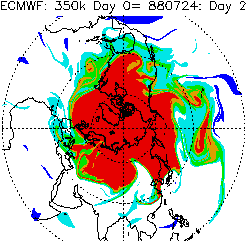 |
b)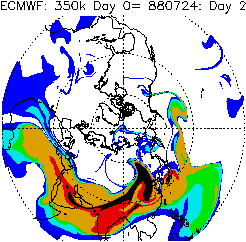 |
c)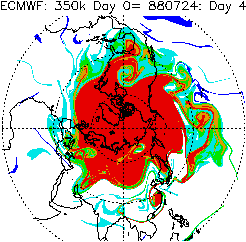 |
d)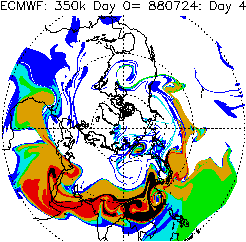 |
The moisture input into the upper troposphere and lower stratosphere experiences a strong seasonality. High moisture values are found during the summer monsoon season (June-October). The largest values occur in association with the Asian summer monsoon. The seasonal shift of moisture input follows the migration of the monsoon. Moistening also occurs due to the Mexican monsoon, but moisture values are much lower there.
In the southern hemisphere, the seasonal moisture input is strongest during southern summer. Because the southern hemisphere does not have such an intense monsoon system in summer, the moistening is weaker than in the northern hemisphere. Therefore, if this mechanism proves to be quantitatively important, it may explain the finding that the extratropical lower stratosphere in the summer hemisphere is moister during northern summer than it is during southern summer.
In this study, the mechanism for moistening the lower stratosphere has been elucidated by using data from the ECMWF Re-Analyses. Since no direct humidity measurements were included in the ECMWF assimilating model at the altitudes that are of interest in this study, independent MOZAIC aircraft data are used to validate the findings. These comparisons show a good overall agreement between MOZAIC and ECMWF data, though the ECMWF data are spatially smoother than the MOZAIC data. In Fig. 4 and Fig. 5 an example is shown of a flight track that intersected a filament of moist, low potential vorticity air revealed by the ECMWF data. Fluctuations of relative humidity and ozone measured along the flight track support the inferences made from the ECMWF data.
|
Fig. 4: Potential vorticity (upper panel) and specific humidity (lower panel) on day 4 (23.7.1995) of a contour advection calculation that was initialised on 19.7.1995 on the 340 K surface. The red area in the upper panel marks stratospheric air. A rolled up filament of tropospheric origin can be seen north of 60N at about 90E. In the humidity field this filament is characterised by locally high values. Superimposed is the flight track from a MOZAIC flight that intersected the rolled up tip of the filament. |
Fig. 5: Results from MOZAIC flight from Vienna to Tokyo on 23.7.1995 that intersected the rolled up filament visible in Fig. 4 between 15.30 and 17 hours UTC. (a) Relative humidity in per cent as measured by the MOZAIC sensor (solid line), relative humidity from ECMWF data interpolated onto the flight path (dotted line), and flight level in hPa (thick solid line). (b) Ozone in ppbv from MOZAIC (solid line) and potential vorticity in potential vorticity units (PVU) from ECMWF. Ozone concentra- tions greater than approx. 100 ppbv and potential vorticity values greater than approx. 2.5 PVU indicate stratospheric air. |